Technical Details of D 263®
Outstanding and adaptable technical advantages
Material Properties of D 263® M
1. Optical properties
| Optical Properties | Value |
|---|---|
| Refractive index* ng | 1.5354 |
| Refractive index* nF' | 1.5305 |
| Refractive index* nF | 1.5300 |
| Refractive index* ne | 1.5255 ± 0.0015 |
| Refractive index* nd | 1.5231 |
| Refractive index* nD | 1.5230 |
| Refractive index* nC' | 1.5209 |
| Refractive index* nC | 1.5204 |
| Abbe value νe | 55 |
| Photoelastic constant in (nm/cm)/Mpa | 34.7 |
* Refractive indices: Pretreatment of samples.
Condition as supplied ["as drawn"]
2. Thermal properties
| General thermal properties | Unit | Value |
|---|---|---|
| CTE (Coefficient of thermal expansion) α | 10-6·K-1 (20 °C; 300 °C) | 7.2 |
| Mean specific heat capacity cp | in J/(g·K) (20 °C; 100 °C) | 0.8 |
| Transformation temperature Tg | in °C | 557 |
| Viscosities | Viscosity lg ŋ in dPas | Temperature in °C |
|---|---|---|
| Strain point | 14.5 | 529 |
| Annealing point | 13.0 | 557 |
| Softening point | 7.6 | 736 |
3. Mechanical properties
| Mechanical Properties |
Unit | Value |
|---|---|---|
| Density ρ | in g/cm³ | 2.51 |
| Young's modulus E | in kN/mm² | 72.9 |
| Poisson's ratio µ | 0.21 | |
| Torsion modulus G | in kN/mm² | 30 |
| Knoop hardness | HK 0.1/20 | 470 |
| Vickers hardness | HV 0.2/25 | 510 |
Chemical toughening (for thickness = 0.145 mm)
| Unit |
Value |
|---|---|
| Temperature ϑ in °C | 390 |
| Time t in h | 4 |
| Compressive stress (CS) in MPa | 290 |
| Depth of layer (DoL) in µm | 15 |
4. Chemical properties
| Hydrolytic resistance (acc. to DIN ISO 719) | Value |
|---|---|
| Class | HGB 1 |
| Equivalent of alkali per gram glass grains in µg/g | 20 |
| Acid resistance (acc. to DIN 12116) | Value |
|---|---|
| Class | S3 |
| Half surface weight loss after 6 hours in mg/dm² | 2.1 |
| Alkali resistance (acc. to DIN ISO 695) | Value |
|---|---|
| Class | A 2 |
| Surface weight loss after 3 hours in mg/dm² | 88 |
5. Electrical properties
| Dielectric constant εr (at ϑ = 25 °C) | Value |
|---|---|
| at 1 MHz | 6.7 |
| at 1 GHz | 6.4 |
| at 5 GHz | 6.3 |
| Dissipation factor tan δ (at ϑ = 25 °C) |
Value |
|---|---|
| at 1 MHz | 61·10-4 |
| at 1 GHz | 74·10-4 |
| at 5 GHz | 101·10-4 |
| Electric volume resistivity ρD (for alternate current 50 Hz ) |
|---|
| 1.6·108 ( ϑ = 250 °C) |
| 3.5·106 (ϑ = 350 °C) |
6. Transmittance values
Spectral transmittance: 250 - 3150 nm
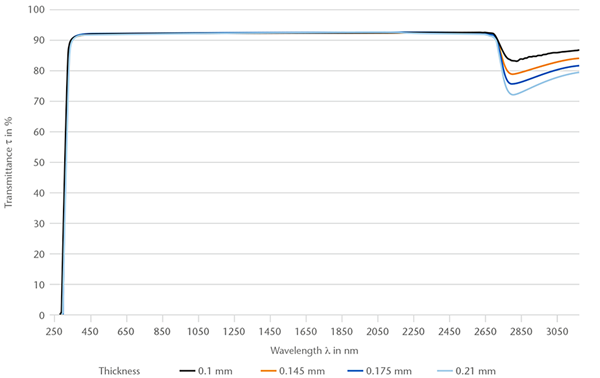
Spectral transmittance: 250 - 450 nm
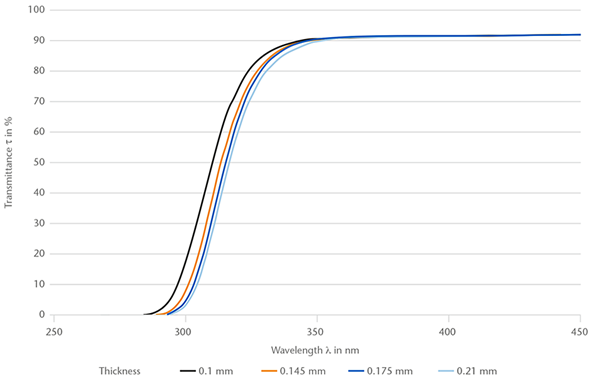
| Wavelength in nm at thickness 0.145 mm: | τ (λ) in % |
|---|---|
| 254 | < 0.1 |
| 380 | 91.2 |
| 632.8 | 91.9 |
| 1064 | 92.2 |
| Edge wavelength λc (τ = 0.46) at thickness in mm | Wavelength in nm |
|---|---|
| 0.100 | 308 |
| 0.145 | 312 |
| 0.175 | 314 |
| 0.210 | 315 |
| Luminous transmittance at thickness in mm | τvD65in % |
|---|---|
| 0.145 | 91.7 ± 0.3 |
Material properties of D 263® bio
1. Optical properties
| Optical Properties | Value |
|---|---|
| Refractive index* ng | 1.5354 |
| Refractive index* nF' | 1.5305 |
| Refractive index* nF | 1.5300 |
| Refractive index* ne | 1.5255 ± 0.0015 |
| Refractive index* nd | 1.5231 |
| Refractive index* nD | 1.5230 |
| Refractive index* nC' | 1.5209 |
| Refractive index* nC | 1.5204 |
| Abbe value νe | 55 |
* Refractive indices: Pretreatment of samples.
Condition as supplied ["as drawn"]
2. Thermal properties
| General thermal properties | Unit | Value |
|---|---|---|
| CTE (Coefficient of thermal expansion) α | 10-6·K-1 (20 °C; 300 °C) | 7.2 |
| Mean specific heat capacity cp | in J/(g·K)(20 °C; 100 °C) | 0.8 |
| Transformation temperature Tg | in °C | 557 |
| Viscosities | Viscosity lg ŋ in dPas | Temperature in °C |
|---|---|---|
| Strain point | 14.5 | 529 |
| Annealing point | 13.0 | 557 |
| Softening point | 7.6 | 736 |
3. Mechanical properties
| Mechanical Properties |
Unit | Value |
|---|---|---|
| Density ρ | in g/cm³ | 2.51 |
| Stress optical coefficient C | 1.02·10-12 m²/N | 3.4 |
| Young's modulus E | in kN/mm² | 72.9 |
| Poisson's ratio µ | 0.21 | |
| Torsion modulus G | in kN/mm² | 30 |
| Knoop hardness | HK 0.1/20 | 470 |
| Vickers hardness | HV 0.2/25 | 510 |
Chemical toughening (for thickness = 0.3 mm)
| Unit |
Value |
|---|---|
| Temperature ϑ in °C | 410 |
| Time t in h | 4 |
| Compressive stress (CS) in MPa | 317 |
| Depth of layer (DoL) in µm | 18 |
4. Chemical properties
| Hydrolytic resistance (acc. to DIN ISO 719) | Value |
|---|---|
| Class | HGB 1 |
| Equivalent of alkali per gram glass grains in µg/g | 20 |
| Acid resistance (acc. to DIN 12116) | Value |
|---|---|
| Class | S 3 |
| Half surface weight loss after 6 hours in mg/dm² | 2.1 |
| Alkali resistance (acc. to DIN ISO 695) | Value |
|---|---|
| Class | A 2 |
| Surface weight loss after 3 hours in mg/dm² | 88 |
Auto fluorescence in >80% transmission spectrum
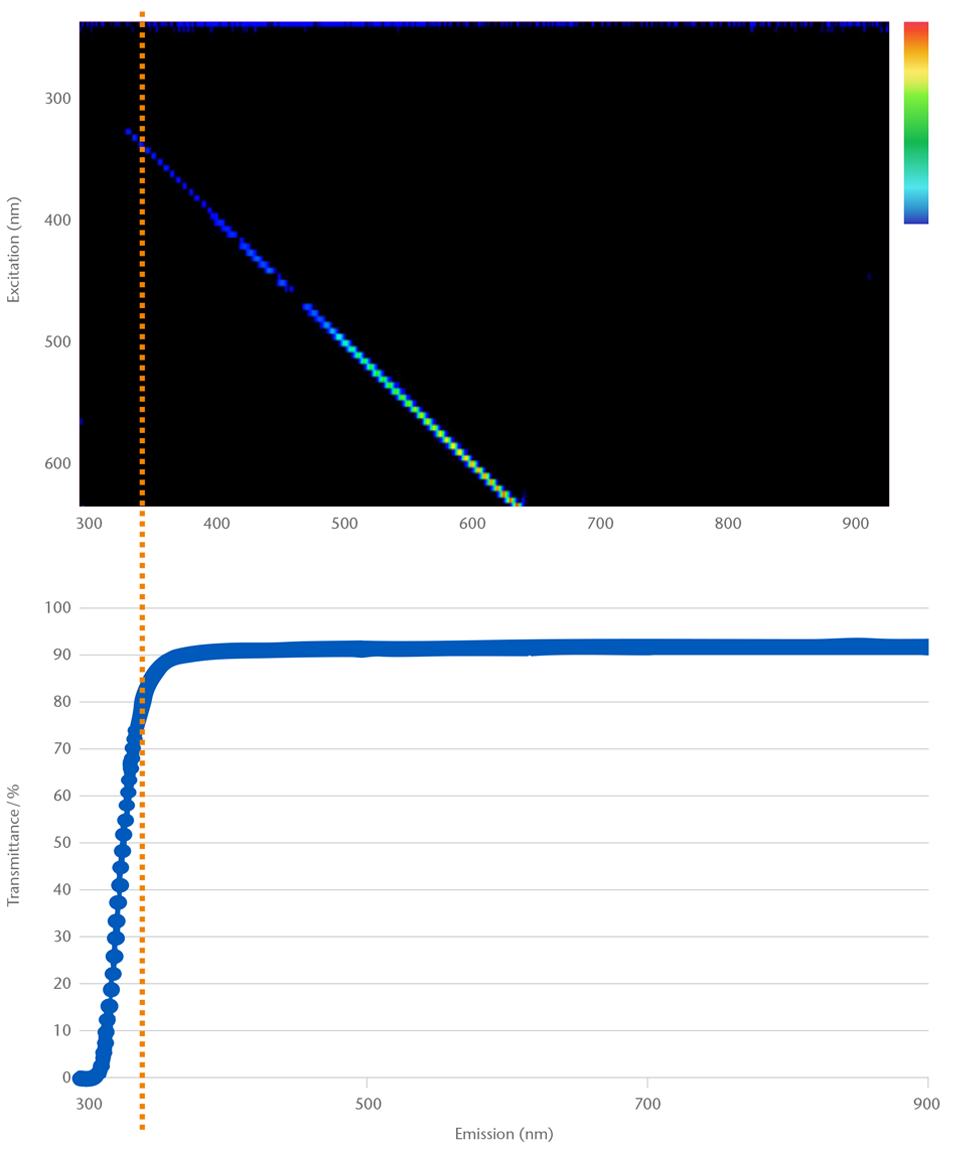
5. Electrical properties
| Dielectric constant εr (at ϑ = 25 °C) | Value |
|---|---|
| at 1 MHz | 6.7 |
| at 1 GHz | 6.4 |
| at 5 GHz | 6.3 |
| Dissipation factor tan δ (at ϑ = 25 °C) |
Value |
|---|---|
| at 1 MHz | 61·10-4 |
| at 1 GHz | 74·10-4 |
| at 5 GHz | 101·10-4 |
| Electric volume resistivity ρD in Ω·cm alternate current 50 Hz |
|---|
| 1.6·108 ( ϑ = 250 °C) |
| 3.5·106 (ϑ = 350 °C) |
6. Transmittance values
Spectral transmittance: 250 - 3150 nm
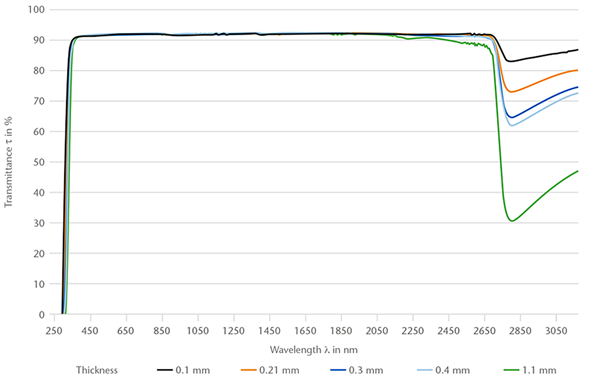
Spectral transmittance: 250 - 450 nm
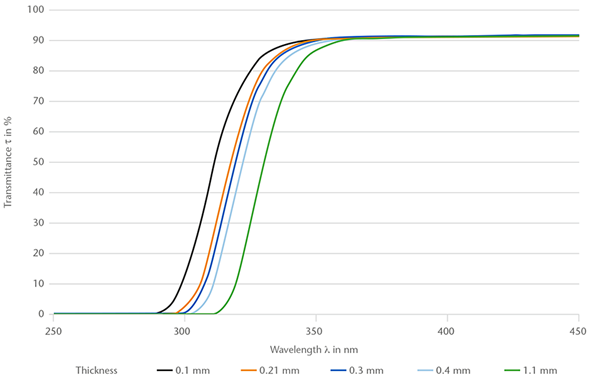
| Wavelength in nm at thickness 0.3 mm: | τ (λ) in % |
|---|---|
| 254 | < 0.1 |
| 380 | 91.2 |
| 632.8 | 92 |
| 1064 | 92 |
| Edge wavelength λc (τ = 0.46) at thickness in mm | Wavelength in nm |
|---|---|
| 0.10 |
308 |
| 0.21 | 315 |
| 0.30 | 318 |
| 0.40 | 321 |
| 1.10 | 329 |
| Luminous transmittance at thickness in mm | τvD65in % |
|---|---|
| 0.3 | 91.7 ± 0.3 |
Material properties of D 263®T eco
1. Optical properties
| Optical Properties | Value |
|---|---|
| Refractive index* ng | 1.5354 |
| Refractive index* nF' | 1.5305 |
| Refractive index* nF | 1.5300 |
| Refractive index* ne | 1.5255 ± 0.0015 |
| Refractive index* nd | 1.5231 |
| Refractive index* nD | 1.5230 |
| Refractive index* nC' | 1.5209 |
| Refractive index* nC | 1.5204 |
| Abbe value νe | 55 |
| Photoelastic constant in (nm/cm)/Mpa | 34.7 |
* Refractive indices: Pretreatment of samples.
Condition as supplied ["as drawn"].
2. Thermal properties
| Thermal Properties - General | Unit | Value |
|---|---|---|
| CTE (Coefficient of thermal expansion) α | 10-6·K-1 (20 °C; 300 °C) | 7.2 |
| Mean specific heat capacity cp | J/(g·K) (20 °C to 100 °C) | 0.8 |
| Transformation temperature Tg | °C | 557 |
| Thermal Properties - Viscosities | Viscosity lg ŋ in dPas | Temperature in °C |
|---|---|---|
| Strain point | 14.5 | 529 |
| Annealing point | 13.0 | 557 |
| Softening point | 7.6 | 736 |
3. Mechanical properties
| Mechanical Properties |
Unit | Value |
|---|---|---|
| Density ρ | in g/cm³ | 2.51 |
| Young's modulus E | in kN/mm² | 72.9 |
| Poisson's ratio µ | 0.21 | |
| Torsion modulus G | in kN/mm² | 30 |
| Knoop hardness | HK 0.1/20 | 470 |
| Vickers hardness | HV 0.2/25 | 510 |
Chemical toughening (for thickness = 0.3 mm)
| Unit |
Value |
|---|---|
| Temperature ϑ in °C | 410 |
| Time t in h | 4 |
| Compressive stress (CS) in MPa | 320 |
| Depth of layer (DoL) in µm | 18 |
4. Chemical properties
| Hydrolytic resistance (acc. to DIN ISO 719) | Value |
|---|---|
| Class | HGB 1 |
| Equivalent of alkali per gram glass grains in µg/g | 20 |
| Acid resistance (acc. to DIN 12116) | Value |
|---|---|
| Class | S 2 |
| Half surface weight loss after 6 hours in mg/dm² | 1.4 |
| Alkali resistance (acc. to DIN ISO 695) | Value |
|---|---|
| Class | A 2 |
| Surface weight loss after 3 hours in mg/dm² | 88 |
5. Electrical properties
| Dielectric constant εr (at ϑ = 25 °C) | Value |
|---|---|
| at 1 MHz | 6.7 |
| at 1 GHz | 6.4 |
| at 5 GHz | 6.3 |
| Dissipation factor tan δ (at ϑ = 25 °C) |
Value |
|---|---|
| at 1 MHz | 61·10-4 |
| at 1 GHz | 74·10-4 |
| at 5 GHz | 101·10-4 |
| Electric volume resistivity ρD in Ω·cm (at 50 Hz) |
|---|
| 1.6·108 ( ϑ = 250 °C) |
| 3.5·106 (ϑ = 350 °C) |
6. Transmittance values
| Wavelength in nm at thickness 0.3 mm: | τ (λ) in % |
|---|---|
| 254 | < 0.1 |
| 380 | 91.2 |
| 632.8 | 92.0 |
| 1064 | 92.0 |
| Edge wavelength λc (τ = 0.46) at thickness in mm | Wavelength in nm |
|---|---|
| 0.10 | 308 |
| 0.21 | 315 |
| 0.30 | 318 |
| 0.40 | 321 |
| 1.10 | 329 |
| Luminous transmittance at thickness in mm | τvD65in % |
|---|---|
| 0.3 | 91.7 ± 0.3 |
D 263® products
SCHOTT D 263® is available as:
- Sheets
- Cut-to-size substrates
- Unpolished substrates and wafers
- FLEXINITY®
To find out more, please see the related products on the overview page.
